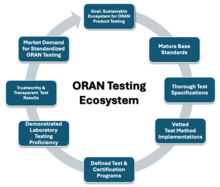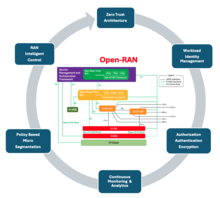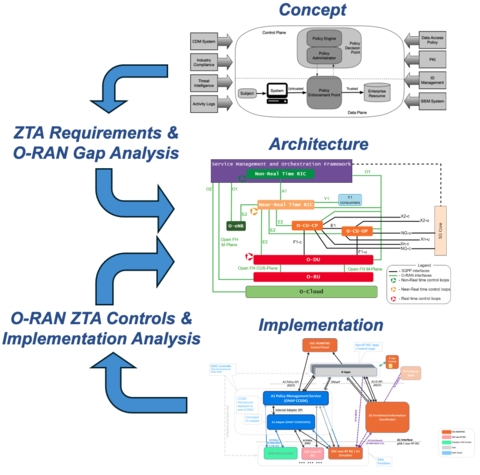Summary
The Advanced Security Architectures for Next Generation Wireless (ASA-NGW) seeks to enhance emerging security standards and guidance efforts for 5G/6G Open RAN and Core technologies, advance the application of Zero Trust networking principles to 5G networks, and evaluate the status of leading open-source software platforms for 5G.

O-RAN technologies seek to transform radio access networks from single vendor solutions based upon proprietary appliances to a disaggregated network architecture of components and functions, with standardized open interfaces, and designed to be deployed in virtualized and cloud native environments. If successful, O-RAN technologies will create an open market for RAN products and services, reduce barriers to entry and spur innovation by evolving to software-based components operating on commodity hardware, and enable wireless network infrastructure to become distributed and dynamic systems that exploit centralized and edge computing infrastructure dynamically optimize performance, reduce operating expenses, and increase resilience.
While the motivation for O-RAN technologies from the mobile service operator’s community is clear, there are many challenges to developing the consensus standards and testing programs necessary to ensure that multi-vendor O-RAN networks are interoperable, secure, and resilient.
Description
National Priorities:
- The National Strategy to Secure 5G and Implementation Plan goals to:
-

- facilitate the rollout of 5G domestically;
- assess the cybersecurity risks to and identify core security principles of 5G capabilities and infrastructure;
- address risks to United States economic and national security during development and deployment of 5G infrastructure worldwide;
- and promote responsible global development and deployment of secure and reliable 5G infrastructure.
Open Radio Access Network (O-RAN) technologies marks a significant step in evolution of next-generation wireless networks and a may be a key enabler for the US IT industry to increase its presence in the supply chain of critical infrastructure components of future wireless networks.

The primary goals of the project are to assess, improve, and expedite emerging O-RAN security standards and testing processes to a level suitable for USG use in mission-critical networks. Near-term objectives are to (1) evaluate the O-RAN alliance testing and certification processes, and the current state of O-RAN Test and Interoperability Centers (OTICs), (2) evaluate current
O-RAN security requirements and test specifications, (3) develop gap analyses of the suitability of existing O-RAN security requirements and testing processes for use by the USG, and (4) develop contributions to O-RAN specifications to address identified gaps and supplemental USG centric guidance to augment industry standards where necessary.
We will augment our standards research and participation with laboratory experimentation using a 5G Open Testbed developed in FY23. We will evaluate multiple 5G RAN and Core open-source implementations against emerging security specifications and evaluate the implementation of O-RAN test methods against these implementations.
We will work primarily with the O-RAN Alliance, OTIC labs, and ATIS as necessary. We also collaborate within the Government in interagency working groups (IWGs) focused on issues of 5G security and resilience for Federal systems.

Our initial focus is the development of a O-RAN Zero Trust Architecture to enhance the security of virtualized, cloud-native, O-RAN functions. We see this area as having both the greatest potential to increase overall network security[1] and the greatest potential risk[2] to the eventual commercial viability of O-RAN technologies. NIST staff will actively engage in the O-RAN alliance working groups on security (WG11), cloud infrastructure (WG11), near-real-time radio intelligent controller (WG3), and testing and integration working groups.
See Additional Technical Details for current project plans.
[1] CSRIC VIII Report on How Virtualization Technologies Can be used to Promote 5G Security and Reliability - https://www.fcc.gov/file/24519/download
[2] O-RAN Alliance O-Cloud Security Analysis Report - https://oranalliance.atlassian.net/wiki/download/attachments/2221408283/O-RAN.WG11.O-CLOUD-Security-Analysis-TR.O-R004-v05.00.03.docx
Major Accomplishments
See Associated Products (below) for a complete listing of our contributions.
- NIST in collaboration with AT&T, MITRE, and Rakuten sponsored a O-RAN Alliance approved new work item to develop a Zero Trust Architecture for O-RAN cloud orchestration and management functions.
- NIST is providing leadership to align O-RAN cloud security with the NIST guidance on zero trust architecture and emerging industry standards (IETF and other) for identity and credentialing of virtualized workloads. If successful, this effort will significantly enhance the security posture of emerging O-RAN standards and resulting product offerings.
- NIST is providing leadership to enhance the existing O-RAN Test Program to improve the quality and utility of the certification and badging process for both O-RAN members and outside organizations that might want to leverage O-RAN testing for use case / users group specific profiles of O-RAN standards.
Current Project Plans
The Advanced Security Architectures for Next Generation Wireless project has established NIST as a significant contributor to the O-RAN standards process. At the request of O-RAN alliance leadership, project contributed to the establishment of new areas of standardization in zero-trust security architecture and the security of the use of AI/ML in RAN control and contributed to efforts to improve the O-RAN testing programs to better serve the needs of network operators and the Government.
In FY25, we will focus our efforts on the security and resilience of RAN intelligent control (RIC) functions in virtualized, cloud-native O-RAN deployments. We see this area as having the greatest potential to transform mobile network architecture and the greatest potential risk to the eventual commercial viability of O-RAN technologies. We will pursue our objectives with both a top-down effort to research and further develop zero-trust security specifications in the O-RAN alliance and a bottom-up effort to prototype and evaluate the inclusion of such zero-trust capabilities in leading open-source O-RAN software frameworks. Specific tasks for FY25-26 include to:
Provide subject matter expertise to the next stage of the O-RAN Alliance zero-trust work plan, including a detailed gap analysis of existing O-RAN security and protocol specifications, the addition of new technical security requirements, controls, and test cases to address identified gaps, and the development of new work items for identified zero-trust capability gaps that are outside the current O-RAN program of work. Expected impact: Enhanced zero-trust O-RAN Alliance security specifications developed in FY25-26.

- Research, design, prototype, and evaluate zero-trust security extensions to O-RAN protocols and interfaces for RAN intelligent control. Existing open-source O-RAN software platforms lack the support of many, if not most, O-RAN security standards. We will select an open-source platform with support for virtualized RIC components and design, implement, and evaluate software extensions to implement the proposed zero-trust security requirements for interfaces between RIC components (e.g., xApps, rApps, near-real-time RIC, non-real-time RIC). Expected impact: research reports on the practical viability of zero-trust security controls for critical RAN-intelligent control interfaces, contributions to the O-RAN zero-trust standards development, and contributions to O-RAN open-source software packages.
- Analyze, document, and prototype security requirements for cloud-native virtualized O-RAN deployments for USG use. The USG has existing security requirements and guidance for the secure deployment and use of cloud-native virtualization technologies. A significant question exists as to how emerging O-RAN security specifications intersect with USG security requirements for virtualization environments and what are the impacts/implications of operating a disaggregated multi-cloud O-RAN deployment on a “USG hardened” cloud platform. We will extend our Open-Source RAN testbed to evaluate these questions and develop additional automation scripts to facilitate other researchers to similar work. Expected impact: Report on the intersection and gap analysis of USG and O-RAN alliance security requirements, a FISMA controls/O-RAN requirements mapping for USG Open RAN deployments, improvements to O-RAN alliances standards, and enhanced O-RAN testbed capabilities.
These tasks will better focus and, as a result, expand NIST’s impact in the design and standardization of O-RAN Alliance advanced security features. New tasks in prototyping reference implementations of these features will initiate new realms of CTL contributions to O-RAN open-source communities. Finally, new tasks focused on documenting the requirements and experimentally evaluating the ramifications of cloud-native ORAN deployments that comply with USG security policies will address an important barrier to USG adoption of open RAN technologies.
Advanced Security Architectures for NextGen Wireless
| Product | Reference |
|---|---|
| Software | Wuthier S., Automation Tool for Deploying 5G O-RAN Testbeds, Open Source Software from the National Institute of Standards and Technology, September 2025.
|
| Standards Contribution | Montgomery D., Inclusion of ICS Template in Test Specification Framework, CR NIST-2025.09.16-TIFG-CR-0021-ICS-Proforma-template-v01.docx, September 2025.
|
| Standards Contribution | Montgomery D., O-RAN ICS Style Guide, Presentation to the O-RAN TIFG Plenary Meeting, July 2025. |
| Standards Contribution | Montgomery D., Hajj M., Revised Section 4.3 Implementation Conformance Statements - Test Specification Framework, O-RAN ALLIANCE Test and Integration Functional Group (TIFG) Change Request NIST-CR-0020, July 2025.
|
| Standards Contribution | Montgomery D., Simplified Definitions for Test Specification Framework., O-RAN ALLIANCE Test and Integration Functional Group (TIFG) Change Request NIST-CR-0016, July 2025.
|
| Standards Contribution | Wuthier S., Covering OAuth 2.0 in PQC Inventory, O-RAN ALLIANCE WG11 (Security) Change Request, June 2025. |
| Standards Contribution | Wuthier S., Covering JSON Web Token (JWT) in PQC Inventory, O-RAN ALLIANCE WG11 (Security) Change Request, June 2025. |
| Standards Contribution, Presentation | Montgomery D., Proposal for O-RAN ICS Style Guide, Presentation to O-RAN Test and Integration Functional Group Meeting., June 2025.
|
| Standards Contribution | Rose S., Monitoring for Advanced Persistent Threats, O-RAN WG11 (Security) Change Request, May 2025. |
| Standards Contribution | Montgomery D., Hajj M., Definition of an O-RAN-specific ICS structure and conditional notation, O-RAN ALLIANCE Test and Integration Functional Group (TIFG) Change Request NIST-CR-0015, May 2025.
|
| Standards Contribution | Wuthier S., Reinartz O., PQC Inventory - IEEE 802.1X related algorithms, O-RAN ALLIANCE WG11 (Security) Change Request, April 2025. |
| Presentation | Rouil R., Montgomery D., Improving O-RAN Resiliency and Testing Through Standards and Testbeds_, Presentation to the NITRD Wireless Spectrum Research and Development working group, April 2025. |
| Standards Contribution | Wuthier S., First attempt on covering ITU-T G8273.2 PTP related algorithms in the inventory, O-RAN ALLIANCE WG11 (Security) Change Request, March 2025. |
| Standards Contribution | Wuthier S., Reinartz O., First attempt on covering MACsec related algorithms in the inventory, O-RAN WG11 (Security) Change Request, March 2025.
|
| Standards Contribution | Montgomery D., Hajj M., Change Request to Improve the Clarity and Usability of the Security Implementation Conformance Statement., O-RAN ALLIANCE WG11 (Security) Change Request NIST-CR-0011, March 2025.
|
| Standards Contribution | Rose S., Srinivasan M., Updating UUID Reference in App LCM TR, O-RAN ALLIANCE WG11 (Security) Change Request NIST CR0010, March 2025.
|
| Standards Contribution | Montgomery D., NIST Comments on Security ICS Format and Contents, Presentation to O-RAN Alliance TIFG, February 2025. |
| Standards Contribution | Rose S., Srinivasan M., Updating UUID RFC Reference in Near-RT RIC Security Study TR, O-RAN ALLIANCE WG11 (Security) Change Request CR0009, February 2025.
|
| Standards Contribution | Rose S., Srinivasan M., IETF RFC reference update for UUID ver 4, O-RAN ALLIANCE WG11 (Security) Change Request, February 2025.
|
| Standards Contribution, Presentation | Montgomery D., Observations on O-RAN Testing: Recommendations to Improve the Utility of O-RAN Certification, Presentation to O-RAN Certification and Badging Task Group, January 2025. |
| NIST Publication | Montgomery D., Open Radio Access Network (ORAN) Testing Ecosystem: Observations and Recommendations, Initial Public Draft NIST Interagency Report (IR XXXX), January 2025. |
| Standards Contribution | Rose S., Updating the ZTA WI Technical Report with the O-DU Gap Analysis, O-RAN ALLIANCE WG11 (Security) Change Request, November 2024.
|
| Standards Contribution | Rose S., Updating the ZTA WI Technical Report with the O-CU Gap Analysis, O-RAN ALLIANCE WG11 (Security) Change Request, November 2024.
|
| Presentation | Rose S., Zero Trust Perspectives at NIST, Invited presentation to Zero Trust Standardization Workshop, O-RAN ALLIANCE Ad-hoc F2F Meeting, Ericsson Canada HQ, October 2024. |
| Workshop | Rose S., Montgomery D., North America Workshop for Zero Trust Architecture in Mobile Standards, Joint O-RAN / 3GPP Workshop on Mobile Network Security., October 2024.
|
| NIST Publication | Liu P., Lee K., J. Cintrn F., Wuthier S., Savaliya B., Montgomery D., Rouil R., Blueprint for Deploying 5G O-RAN Testbeds: A Guide to Using Diverse O-RAN Software Stacks, NIST Technical Note (NIST-TN-2311), September 2024. |
| Workshop | Montgomery D., e., Towards a Robust and Sustainable Open-Source Software Ecosystem for Future Wireless Research and Development, Networking and Information Technology Research and Development (NITRD) Program, September 2024.
|
| Workshop, Presentation | Montgomery D., International Open RAN Symposia (IORS), Workshop on Testing, September 2024.
|
| Panel Session | Montgomery D., International Open RAN Symposia (IORS), Invited panel moderator, September 2024.
|
| Standards Contribution | Rose S., Fernandes C., Continuous Security Monitor Work Item Description, O-RAN ALLIANCE WG11 (Security) Work Item Description, August 2024.
|
| Standards Contribution | Rose S., Borchert O., Poretsky S., Add NIST Security Terms and Definitions, O-RAN ALLIANCE WG11 (Security) Change Request, August 2024.
|
| Working Group | Montgomery D., FCC CSRIC IX, Participant in Working Group 6: Preparing for 6G Security and Reliability, June 2024. |
| Standards Contribution | Rose S., Borchert O., Zwingmann H., Stange M., Editorial Changes and Corrections to Conform to O-RAN Rules, O-RAN Alliance Change Request, WG11, May 2024.
|
| Standards Contribution | Rose S., Borchert O., Zwingmann H., Stange M., Splitting Compound O-RAN Requirements, O-RAN Alliance WG11 Change Request, May 2024.
|
| Presentation | Montgomery D., Towards Verifiable ZTA in O-RAN, Acceleration of Compatibility and Commercalization for Open RAN Deployments (ACCORD) Technical Workshop, April 2024.
|
| Presentation | Rose S., Applicability of NIST Zero Trust Tenets 4, 6 and 7 to O-RAN, Presentation to WG11 Zero Trust Architecture Work Item Team, O-RAN Alliance, March 2024. |
| Presentation | Zwingmann H., Borchert O., Rose S., Stange M., Security Requirements Specifications (SecReqSpec) Insights and proposed way forward, Presentation to WG11 Pleanary during the O-RAN Alliance F2F meeting in Athens, 2024, February 2024.
|
| Standards Contribution | Rose S., Bykampadi N., Shah P., P. Adharapurapu K., NIST ZT Tenet-3 Applicability for O-RAN, O-RAN Alliance WG11 Change Request, February 2024.
|
| Standards Contribution | Rose S., et_al., Zero Trust Architecture (ZTA) for O-RAN, WG11-2023-08 Work Item Description, January 2024.
|
| Standards Contribution | Rose S., Application of the NIST AI Risk Management Framework, O-RAN Change Request, October 2023.
|
| Standards Contribution | Borchert O., Rose S., SecReq Specification Drafting Rule Adjustment, O-RAN Change Request, September 2023. |
| Standards Contribution | Borchert O., Rose S., SecRecSpec O2 Interface Modification, O-RAN Change Request, September 2023. |
| Presentation | Rose S., Borchert O., Zero Trust Archtecture, ATIS TOPS Enhanced Zero Trust and 5G Meeting Series, February 2023. |
| Report | Montgomery D., et. al. members of CSRIC 8 Working Group 3, Report on How Virtualization Technology Can Be Used to Promote 5G Security and Reliability, Communications Security, Reliability, and Interoperability Council VIII, December 2022.
|
| Video | Clancy C., Solari C., Rose S., Islam J., Thottan M., TIA QuEST Forum's ICT Summit: 5G Security, Supply Chain and Zero Trust Architectures, Telecommunications Industry Association Webinar Series, October 2020. |
Collaborators (42) = ANDRO Computational Solutions, AT&T, Accenture, Altiostar Networks, CTIA, Cisco, Comtech Telecommunications Corp., Cox Communications, Cybersecurity and Infrastructure Security Agency (CISA ECD), Dell, Dell Technologies, Deutsche Telecom, Deutsche Telekom, DoD, Ericsson, FCC, FirstNet, Hewlett Packard Enterprise, Intel Corporation, Internet of Trust, LLC, MITRE, Mavenir, Microsoft Corporation, Motorola Solutions, NEC, NITRD, NSA, NSF, NTIA, NTIA ITS, National Security Agency (NSA), Nokia, O-RAN Alliance, Palo Alto Networks, Qualcomm Incorporated, Rakuten, Rakuten Mobile, Rakuten Symphony, Rural Wireless Association, T-Mobile USA, Verizon

